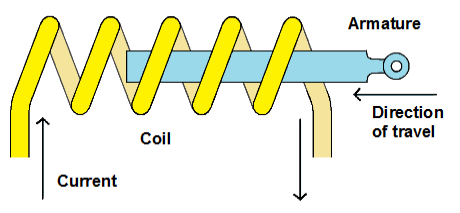| Vocademy |
Electromagnets, Solenoids and Relays
Solenoids
In the field of physics any coil of
wire used for its electromagnetic properties is called a solenoid.
However, in electronics and mechanics, the term "solenoid" is used for
an electromagnetic actuator.

| An electromagnetic solenoid. When current flows through the coil the magnetic field pulls the armature into the coil. |
A solenoid is used in a car to engage
the starter motor with the engine. Solenoids may also be used to
operate valves, coin returns in vending machines or any other
mechanical device that needs to be operated electrically. The armature
of a solenoid may be based on a permanent magnet. If so it can either
be pulled or pushed depending on the polarity of the voltage connected
to the coil.
Relays
A solenoid-operated switch is called a relay. A typical relay has a hinged armature connected to switch contacts.
 |
||||
|
Relays are usually used to allow a
small current to switch a much larger current. For example, the
“solenoid” of a car is actually a relay.1 It takes far more current to
operate a starter motor than the key switch can handle. Therefore, the
key switch energizes the electromagnet of the solenoid/relay, which can
easily handle the 500 amperes or more that it takes to crank an engine.
Relays are also used for remote operation of many switches at one time.
One small switch or other driver circuit operates the relay coil where
the relay has several switches that work in unison. There are nearly as
many types of relays as there are hand-operated switches. The simplest
is a single-pole-single-throw. The schematic symbol for a relay is
simply an inductor near a switch. Sometimes, as in the example above,
the switch contacts are drawn in a style that resembles the mechanical
operation of the relay.
Electromagnets, Solenoids and Relays
| Vocademy |
